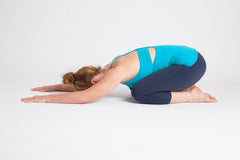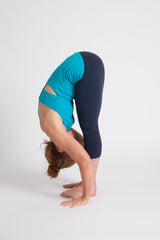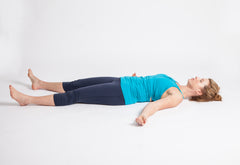The day after my sister died, I was alone in the crowded San Jose airport awaiting a flight back home to Milwaukee. A week-long death-bed vigil had left me exhausted and disoriented. Feeling precariously close to fainting I wanted more than anything to lie on the dirty floor and sob out the pain of loss; instead I knelt down on my coat on the floor and folded forward, assuming a yoga posture called Child’s Pose Variation: shins and tops of the feet on the floor, buttocks resting on top of feet, chest against thighs, forehead on the ground, arms resting by my sides. I consciously slowed my breathing, bringing focused awareness to the comforting feel of my chest against my thighs on each inhalation and exhalation.
Child’s pose is a yogic resting pose meant to center and calm the body, mind and emotions. As I stayed in the pose the feeling of floating above the earth that had been with me since my sister’s last breath subsided. On the flight home I periodically folded my body forward in my seat whenever I felt a wave of grief arise; folding forward allowed me to ride waves of grief without being pulled under by sorrow. By the time I arrived home I knew that the practice of yoga would be an important part of my grief healing journey.
Yoga Can Ease the Anxiety and Stress Associated with Grief
Yoga is a mindful practice that involves bringing non-judgmental awareness to your breath, movement, posture, thoughts and emotions. Practicing non-judgment during the grieving process can aid in easing anxiety and stress by helping you to be with what is as it is with acceptance.
Yoga practices offer a way to experience greater inner comfort in the grieving process by self-compassionately aiding in:
- Physical softening through movements, breathing techniques and postures that help the body release tightness or constriction without demanding that it does so
- Emotional soothing through movements, breathing techniques and postures that provide emotions a safe place to flow and be felt
- Mental allowing by providing a way to foster the skill of non-judgment through movements, breathing techniques and postures that emphasis present moment awareness
Uncertainty is inherent in loss: what happens now? What does the future hold? Where do I belong now? The ritualistic aspects of yoga (doing set/known poses on a mat that are familiar and therefore comforting) can aid in adjusting to an environment in which your loved one is now absent by providing a known place - a safe place of belonging – in which to work through the pain of loss.
Yoga Can Help You Better Manage Your Energy During Mourning
It can be helpful to think of the mourning period as a time of energy drain or energy depletion, negatively affecting the optimal functioning of the immune, hormonal and nervous systems. Depletion or drain is experienced as discomfort or pain of some sort in the body (such as held tension or tightness), mind (for example, difficulty concentrating or elevated mental noise) or emotions (difficulty controlling or regulating emotions). Yoga enhances physiological functioning by optimally balancing the body’s energy, easing discomfort and providing a way to ride waves of grief.
Energy management can entail either self-care through movement or rest – both of these things can be found in various yoga practices. For example:
Yoga flow practices such as vinyasa focus on connecting the breath, movement (for example, one movement, one breath) and the mind through movement from one pose to another in a continuous and smooth way. Through movement that connects breath, body and mind, flow practices can keep the energy of draining thoughts and emotions (such as sadness, anger, preoccupation etc.) from accumulating or getting stuck in the body thereby contributing to a greater sense of well-being.
Restorative yoga practices such as yin are slow-paced practices that encourage physical, mental and emotional relaxation by focusing on the holding of poses, stillness and regulated mindful deep breathing. Restorative poses are often done with supportive props such as blankets, bolsters and large blocks. The slower pace and more passive stretching done in restorative practices also aid in discharging depleting energies and renewing inner balance.
What style of yoga would be most beneficial in navigating your grief journey can best be determined by taking an on-line or in-person yoga class; as grief can be a time of loneliness and aloneness I often encourage my grief clients to take in-person classes at a community-based yoga studio where social connection and a sense of belonging is fostered. The studio experience also provides instruction in proper alignment and modifications regarding poses. For interested clients I provide instruction in mindfulness-based stress reduction therapeutic yoga.
Forward-folding Poses/Asanas for Grief
When we are grieving – especially when fresh grief is present – the body naturally wants to curl in on itself by folding forward. That was certainly my body’s response when I was in the airport, overcome by grief which is why I intuitively did Child’s Pose Variation. Here are some options for forward folding poses; these poses help to calm and balance the nervous system, as well as lengthen the body when muscles feel tight or contracted. Poses can be done for however long feels right to you.

Child’s Pose: Come down onto the floor, shins and tops of the feet on the floor, big toes together, knees spread apart. Shift your hips back toward your heels and then reach your arms out in front of you. Rest your head on the floor, yoga mat, folded blanket or a block. To provide greater comfort for your neck and shoulders you may wish rest your hands up off your fingertips or on blocks.
Seated Forward Fold Pose: Sit on the floor with your legs straight out in front of you, legs together or hip-width apart. Make sure you are sitting high up on your sitting bones. Inhale and stretch both arms toward the ceiling, arms parallel to your ears. As you exhale, bend forward while continuing to keep your arms and hands reaching upward and then finally outward toward your toes. If you have back issues, you may wish to place a blanket under your hips and keep a slight bend in your knees.

Standing Forward Fold: Stand with your feet parallel, hip distance apart. Inhale and raise your arms overhead in a full body stretch, then exhale and slowly bring your hands down toward the floor. Stop when you need to inhale, rest for a breath, and then exhale and stretch further down. You may slightly bend your knees. When you’re down as far as you can comfortably go, breathe naturally for a few breaths or for however long is comfortable. When you feel ready, inhale and slowly return to the standing position
When doing this pose, allow your head to hang heavy and bring your gaze to your legs. Regarding hand placement you have the option of: letting your arms hang down toward the floor; resting your hands lightly on your legs wherever is most comfortable; or clasping opposite elbows with opposite hands. A slight bend in the knees will protect your back.
To enhance the release of tension caught in the body, Standing Forward Fold or Seated Forward Fold can be paired with the mindful practice of The Relaxing Sigh. The steps for The Relaxing Sigh are:
- Sit or stand straight, legs hip distance apart.
- As you raise your arms, inhale.
- Then as you fold forward exhale, breathing out a deep, audible sigh.
- Don’t think about inhaling - just allow your breathing to return to a natural rhythm and pace.
- If you choose, do eight of these relaxing sighs with or without a forward fold so as to experience the feeling of relaxation.
Additional Poses for Attending to the Stress of Grief

Knees to Chest Pose: Lying on your back, draw your knees in toward the chest, grasping your legs just below the knees. On an inhale, release the knees slightly away from the chest, on the exhale hug the knees back in. To give yourself a gentle back massage, gently rock from side to side, moving the knees around in circles, first one way and then the other, to release lower back tension.

Mountain Pose: Standing: Stand upright, feet together with your arms by your sides and palms slightly open. Don’t lean forward or backward; keep your head squarely between your shoulders. Distribute your weight evenly between both feet with your knees, hips, shoulders aligned. Breathe naturally.
When grieving, physical balance is often elusive. Mountain Pose while standing can be done to help strengthen balance. If trying to balance while standing is too challenging, Mountain Pose can be done in a seated position.
Mountain Pose Seated: Sit cross-legged on the ground or on a block or blanket. Rest your hands on your knees. Allow the body to be still. Allow your eyes to close or remain softly open, gazing at a point in front of you. As you sit, in this strong posture, imagine that the strength and wholeness of a mountain resides within you.

Warrior 2: This is a strength pose. A client once described to me how she would do this pose at work in the privacy of the restroom during the early stages of grief in order to shore-up her strength for getting through the day. I was astonished when my client told me this as Warrior 2 had also been my strategy for drawing-in greater strength when I was experiencing a profound loss and often had to “muscle” my way through the day.
Start in mountain pose. Take a wide step forward with your right foot; then step your left foot back, aligning the angled arch of the left foot with the back center of the right foot. The left leg is straight; your weight is evenly distributed between both feet. Extend your arms from your sides at shoulder level, then gaze out beyond your right arm, keeping your torso stationary. Breathe naturally, then gently release, return to mountain pose and repeat on the other side.

Savasana: This pose promotes deep relaxation and rest. Lie down flat on your back. Stretch your arms and legs slightly out and away from the body. Gently close your eyes. Breathe naturally evenly with an intention of relaxation or allowing.
You Can Add a Mantra to Aid in the Process of Letting Go
In mindfulness-based stress reduction yoga practice any pose can be paired with a verbal affirmation or mantra – a word or sound repeated to aid in concentration. For example, you might silently say the mantra “breathing in” on every in-breath, and “breathing out” on every out-breath, or “I am strong” on every in-breath and “I am resilient” on every out-breath. Mantras can be especially beneficial for quieting the mind when a high level of mental noise/ mind chatter is present.
Hear more from Elizabeth Lewis on the podcast: From Mourning to Mindfulness: Yoga and the Grief Journey
Photo Credit: Elizabeth Lynch
Resources
Meg Galarza owner of YogaOne Studio, Cedarburg, WI
Training Manual: FeelYourBody Teacher Training School/Horizons Stress Management Program
A Mindfulness-based Stress Reduction Workbook by Bob Stahl and Elisha Goldstein
The Relaxation and Stress Reduction Workbook by Martha Davis, Elizabeth Robbins Eshelman and Matthew McKay

